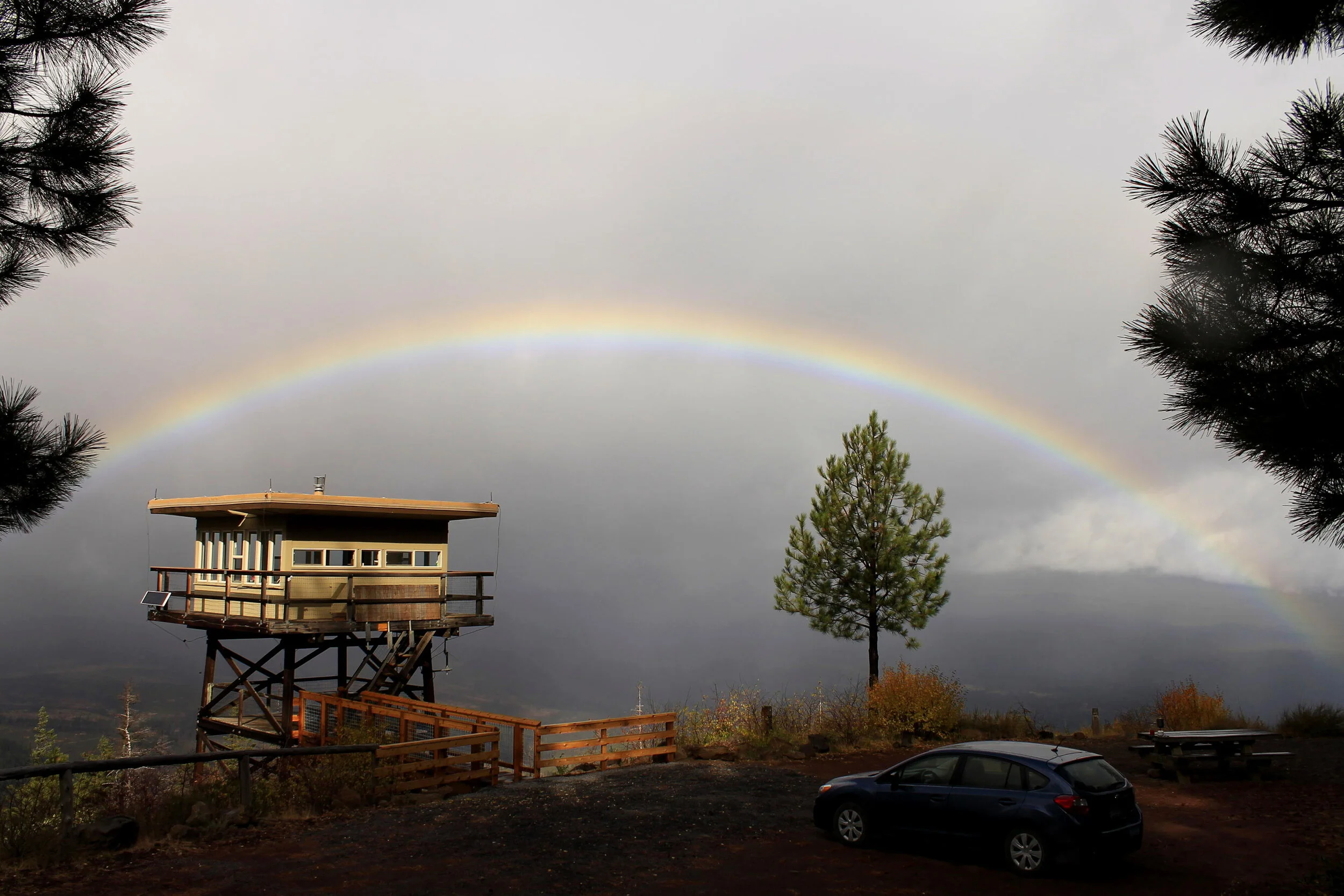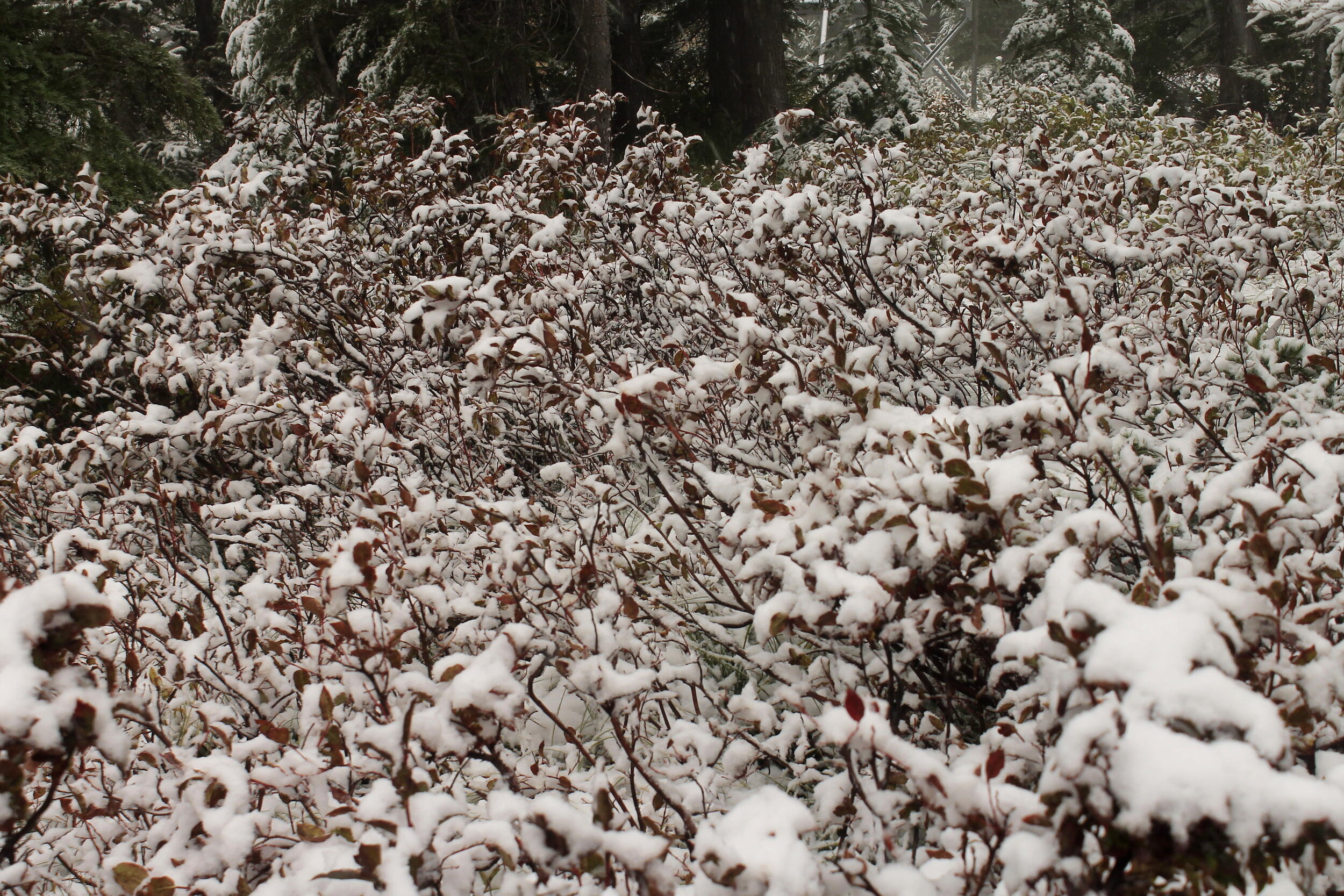Staying in a lookout tower is one of the finest experiences you can have in the mountains. To wake up in a small cabin on a mountaintop, with the mountains spread out before you…there’s nothing finer. Of course, many folks feel this way, and reserving a lookout tower can be incredibly difficult. I was lucky to snag Indian Ridge for a Thursday and Friday nights the first weekend in October, and so a plan was assembled to meet up with friends to spend the weekend in the lookout.
Now take a look at the photo above. That looks pretty cool, right? To be alone with good friends on a mountaintop in the snow…it’s the stuff that dreams are made of.
Indian Ridge has no heat.
With that in mind, we knew we’d need to prepare for cold weather. The forecast said rain, so we came prepared for cold nights and what promised to be a memorable weekend in the mountains.
Wendy and I drove up on Thursday evening (her weekend is Friday and Saturday, so I have adopted this as my weekend too). Not long after we arrived, our friends made it there, and we were able to share some hot tea and dinner. It was sleeting and utterly nasty outside, so we all retired to the somewhat-friendly confines of the lookout.
When we woke the next morning, this is what we saw:
I can’t say we didn’t expect foul weather, considering it was sleeting when we went to bed the night before. We bundled up and went outside to go explore the snowy beauty:
It was so gorgeous outside! Wendy and I aren’t really snow people. We don’t snowshoe very often, we don’t ski and we rarely go anywhere in the snow in general. I think both of us prefer the dry, open spaces of the desert in winter to the snowy mountains. But I do love them once I am there, in the snow. Perhaps I should try harder.
After some time curled up in our sleeping bags back in the lookout waiting for it to warm up, we decided to drive down to the valley below to go hiking. This was always the original plan for the weekend, to stay high and hike low. Cold weather has a way of sapping your motivation though, and we figured we should go explore before we ended up stuck inside the lookout all day.
The nearest hike to the lookout is the French Pete Creek Trail. This is one of the classic hikes of the western slopes of the Three Sisters Wilderness. I first hiked French Pete Creek in March 1992…an eternity ago. This was long before the fires, and long before all the bridges had disappeared from the hike. It was one of the most interesting hikes I had ever done up to that point. The second crossing of French Pete Creek was waist-deep, but we made it to the 5-mile marker. What an adventure! This is what I had to say in my hiking journal:
French Pete Creek 3/22/1992
10.4 miles
1,000 feet elevation gain
Note: Wading that rocky creek is very, very cold!
Yes, I kept a hiking journal. You shouldn’t be surprised.
Anyway, it warmed up as we drove back into the valley, and the weather looked pleasant for hiking. We decided to hike only to the first creek crossing before turning around to explore more of the valley. It felt good to be back in the Three Sisters Wilderness again:
As it was meant to happen, I would end up in the Three Sisters Wilderness again the next weekend. But that’s a different story for a different post.
Signs of damage from the 2017 fire were apparent immediately. As I’ve stated repeatedly in my writing, I don’t mind hiking in fire-damaged forest. The damage here did not match my memories of how verdant French Pete Creek was though, and it actually made me a little sad. This is a sample of what the trail looks like now:
There was still beauty everywhere, though. We sat down for a little while when we reached the first creek crossing and marveled at how beautiful it was in spite of the lost bridge and fire damage:
I still remember the huge downed cedar that formed the bridge over the creek here. I’ve looked through our photo albums and I can’t find any photos from our hike here in 1992, so it will have to live on in my memory.
Anyway, on the way back Wendy and I lagged behind our friends so I could take some photos of the side creeks. I like how this one turned out:
The sun started to come out when we got to the trailhead, so we decided to go check out Cougar Hot Springs. Somehow I had never been there before, and of course we didn’t pack anything to go to a hot springs. Our friends went and soaked anyway while Wendy and I sat there and chilled.
Cougar Hot Springs. I made sure to snap this photo while all humans were out of view. There were actually a lot of people here.
After Cougar Hot Springs, we drove back up to Indian Ridge for what figured to be a more pleasant evening. Along the way, we passed a wondrous display of fall color that we hadn’t noticed on our drive in the night before:
As promised, this evening was far more pleasant than Thursday night had been. We heated up dinner, made a fire and shared some beers. It was still very cold, but at least this time it wasn’t sleeting on us.
Right before sunset the sun finally came out for good, and it was GLORIOUS:
That night it was a lot warmer inside the lookout, but it was never warm. Let me be clear about this: I am NEVER staying in another lookout this late in the year that doesn’t have a heat source. Thankfully most of them do.
The next morning was bright and beautiful from the start. We had to leave, but the warm and beautiful weather made it tough. Finally, at last, the mountains came out:
It was great to see the Three Sisters after two days of knowing they were out there, behind all the clouds. Our friends decided to leave before us to go explore some more. We were sad to see them go, but so happy that they were able to join us. I snapped a photo of them right before they left:
We love you guys, and we can’t wait to go see you as soon as possible!
After they left, it was up to Wendy and I to close down the lookout. We were sad to go, but we had another adventure ahead of us for that day! We were going to go hike Marion Lake, one of my favorite places in the Mount Jefferson Wilderness. I’ll get to that in my next post. For now, here’s one more photo of Indian Ridge Lookout before we left:
I managed to snag three lookout towers that fall, and we only ended up staying in one of them. With that being said, let me elaborate on some tricks to booking lookout towers:
Don’t book based on when you want to go, book based on what is available (if anything is).
Be on recreation.gov at 7AM (well, a few minutes before actually), ready to book six months in advance. Reservations go on sale six months in advance, and you need to be ready to snag whatever is available, even if it isn’t your first choice.
Look for cancellations. The only time I’ve managed to stay at Green Ridge, the holy grail of Oregon lookout towers, was on a cancellation that one of my friends snagged.
Have your friends help you. We share lookout tower bookings.
Be willing to book days you don’t need to get the days you want.
Last but not least, be patient!
As luck would have it, I managed to book Hager Mountain Lookout for this weekend. I was pretty excited, as I had never succeeded at booking Hager Mountain before. In response to the COVID-19 pandemic, the lookout is now closed to the public. So it goes.
That’s the thing with lookout towers: cherish them when you’re able to stay there. As I said at the start of this post, staying in a lookout tower is one of the finest experiences you can have in the mountains. It doesn’t happen very often…savor the experience.



































